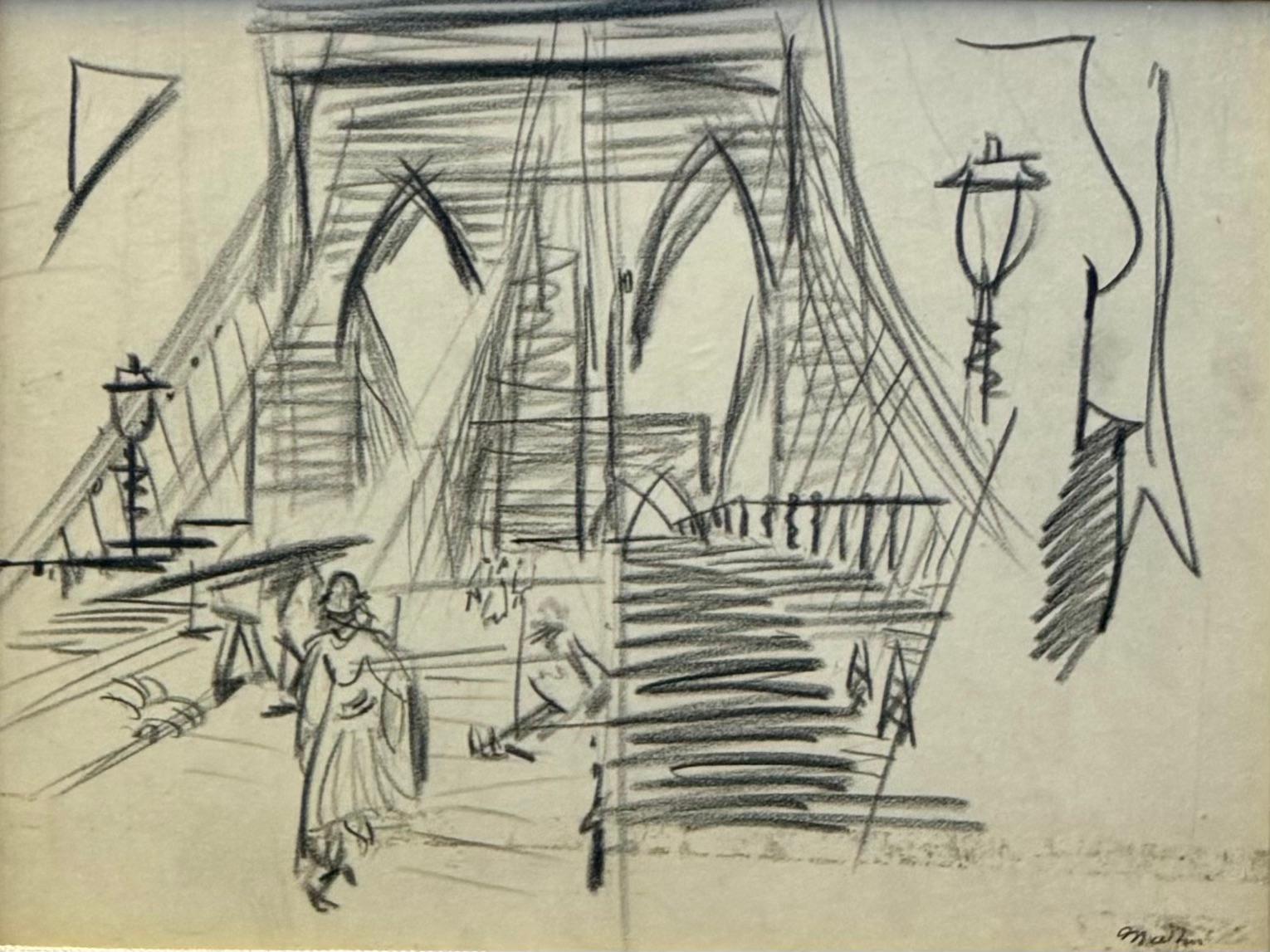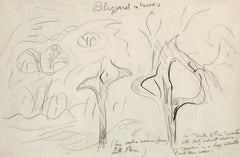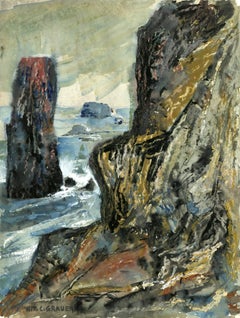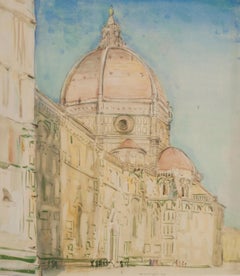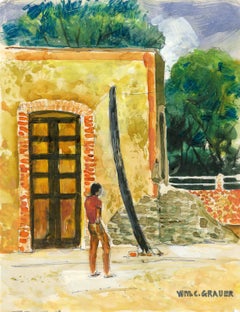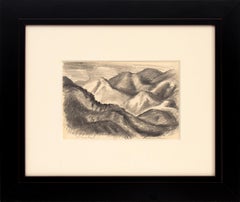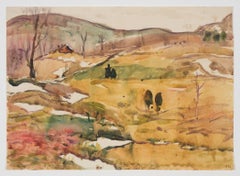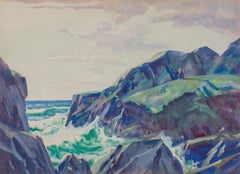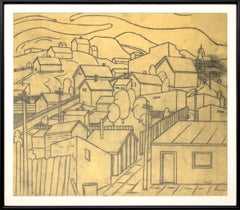Items Similar to Brookdale, New Jersey
Want more images or videos?
Request additional images or videos from the seller
1 of 7
Oscar Florianus BluemnerBrookdale, New Jersey1922
1922
About the Item
Brookdale, New Jersey
Graphite on paper, 1922
Signed with the artist's initials l.l., and dated 1922 (see photo)
Annotated "Brookdale" front and back of sheet
Condition: Excellent
Archival framing with 8 ply acid free rag matting and UV filtering glass. Housed in a Marin style metal leaf, finished corner frame
Frame size: 15 x 16-3/8 x 3/4 inches
Image size: 5 x 6 3/4 inches
Provenance: Estate of the Artist
Courtesy of Wikipedia
Oscar Bluemner (June 21, 1867 – January 12, 1938), born Friedrich Julius Oskar Blümner and after 1933 known as Oscar Florianus Bluemner, was a Prussian-born American Modernist painter.
Early life
Bluemner was born as Friedrich Julius Oskar Blümner in Prenzlau, Kingdom of Prussia (now Germany), on June 21, 1867. He studied painting and architecture at the Royal School of Art in Berlin.
Architecture
Bluemner moved to Chicago in 1893 where he freelanced as a draftsman at the World's Columbian Exposition. After the exposition, he attempted to find work in Chicago. In 1901, he relocated to New York City where he also was unable to find steady employment. In 1903, he created the winning design for the Bronx Borough Courthouse in New York, although it is credited to Michael J. Garvin. The scandal that arose around this took down borough president Louis Haffen for corruption and fraud.
In 1908 Bluemner met Alfred Stieglitz, who introduced him to the artistic innovations of the European and American avant-garde. By 1910, Bluemner had decided to pursue painting full-time rather than architecture.
He exhibited in the 1913 Armory Show. He said that the Americans' contribution failed to match that of the Europeans because the American selection process reflected rivalries and compromises rather than curatorial judgment, resulting in a "melée of antagonistic examples".Then in 1915 Stieglitz gave him a solo exhibition at his gallery, 291. Despite participating in several exhibitions, including solo shows, for the next ten years Bluemner failed to sell many paintings and lived with his family in near poverty.
He created paintings for the Federal Arts Project in the 1930s.
Later life
After his wife's death in 1926, Bluemner moved to South Braintree, Massachusetts. From there in 1932 he contributed a letter to an ongoing debate in the New York Times on the question "What is American Art?". He wrote:
“America sells its shoes, machines, canned beef and so forth in Europe and all over the world not because they have an American style or are wrapped in the American flag, but simply because they are best. Thus also, the French export their paintings and birth-control, and the Germans export sauerkraut and prima donnas, because those things, each, are best. Today, for quality, nationalism, as a race-attribute, means nothing; chemistry, astronomy, or engineering admit, nowhere, of any national flavoring, nor do higher things like religion or philosophy.
Let us, here, make progressive and best painting, each one as he is fit to do, and merely ask: What and when is painting, in a critical sense? ... How can the people agree on what is American style, if the painters themselves, and by their work, disagree profoundly as to what real painting itself is! And there is, and always was, nothing more contemptible, ridiculous and, to art, disastrous, than patrioteering, which thinly veils profiteering.
Ideally, art, pure, is of a sphere and of no country; the first real artists, always and everywhere, have either been importers or immigrants bringing the light with them. El Greco, an immigrant ... defied the Spanish professors ... ; we, now, call his work more truly Spanish than that of his local contemporaries. And in the same sense, the future will not fail to stamp that of our own work as peculiarly American in which the living painter, here, has injected no conscious thought of his hailing from Hoboken or Kankakee, and every consideration of pure and modern painting and of the supreme quality he maybe capable of.”
He had a successful one-man show in 1935 at the Marie Harriman Gallery in New York City. In the New York Times, Edward Alden Jewell called it Bluemner's "apotheosis". He wrote:
He is very much alive and has been working of late ... with robustious [sic] results. These twenty-eight canvases bear the generic title , "New Landscape Paintings." That is because Mr. Blkuemner feels that some degree of "representation" is essential if abstract ideas are to be put over with entire success. However, the artist more fully and more exactly classifies them as "compositions for color themes." He might, if he chose, even call them "color music" without risking the opprobrium that usually attends excursions into so hazardous a field. ... These startling pictures build harmonies and rhythms that depend as a rule on simple statement. Here we find none of the overtones and undertones that some other artists have employed in projecting visual music. Bluemner relies for his effect upon plain, resonant chords. Though modulations of tone occur, these seem of secondary importance in his scheme. There is decidedly something in this new, bold, exclamatory style.
Bluemner died by suicide on January 12, 1938.
Legacy
Stetson University holds more than 1,000 pieces of Oscar Bluemner's work bequeathed in 1997 by his daughter, Vera Bluemner Kouba. In 2009 the Homer and Dolly Hand Art Center at Stetson opened with a primary mission of housing a providing exhibition space for the Kouba Collection. Often overlooked in his lifetime, Bluemner now is widely acknowledged as a key player in the creation of American artistic Modernism, with better-known colleagues such as Georgia O'Keeffe and John Marin.
In 2013, the Montclair Art Museum in New Jersey presented an exhibition of Bluemner's works depicting the landscapes and industrial areas of Paterson, painted between 1910 and 1917, drawn from the Stetson holdings. It marked the centenary of the Paterson silk strike, which had inspired his politics.
An oil painting by Bluemner, Illusion of a Prairie, New Jersey (Red Farm at Pochuck) (1915) sold at Christie's, New York, for $5,346,500 on November 30, 2011.
- Creator:Oscar Florianus Bluemner (1867-1938, American)
- Creation Year:1922
- Dimensions:Height: 5 in (12.7 cm)Width: 6.75 in (17.15 cm)
- Medium:
- Movement & Style:
- Period:
- Condition:
- Gallery Location:Fairlawn, OH
- Reference Number:Seller: FA37421stDibs: LU14012599812
About the Seller
5.0
Recognized Seller
These prestigious sellers are industry leaders and represent the highest echelon for item quality and design.
Platinum Seller
Premium sellers with a 4.7+ rating and 24-hour response times
Established in 1978
1stDibs seller since 2013
784 sales on 1stDibs
Typical response time: 1 hour
Associations
International Fine Print Dealers Association
- ShippingRetrieving quote...Shipping from: Akron, OH
- Return Policy
Authenticity Guarantee
In the unlikely event there’s an issue with an item’s authenticity, contact us within 1 year for a full refund. DetailsMoney-Back Guarantee
If your item is not as described, is damaged in transit, or does not arrive, contact us within 7 days for a full refund. Details24-Hour Cancellation
You have a 24-hour grace period in which to reconsider your purchase, with no questions asked.Vetted Professional Sellers
Our world-class sellers must adhere to strict standards for service and quality, maintaining the integrity of our listings.Price-Match Guarantee
If you find that a seller listed the same item for a lower price elsewhere, we’ll match it.Trusted Global Delivery
Our best-in-class carrier network provides specialized shipping options worldwide, including custom delivery.More From This Seller
View AllBlizzard in Woods
By Charles E. Burchfield
Located in Fairlawn, OH
Blizzard in Woods
Graphite on paper, c. 1945-1963
Unsigned
Provenance: Sid Deutsch Gallery, New York
Annotated with notes for completing the drawing. Deutsch Gallery has handled Bur...
Category
1940s American Modern Landscape Drawings and Watercolors
Materials
Graphite
untitled (Rocks along the Coast)
By William C. Grauer
Located in Fairlawn, OH
untitled (Rocks along the Coast)
Gouache and watercolor on paper, c. 1950
Signed with the estate stamp signature lower left (see photo)
This is a preliminary study for a large exhibition painting...
Category
1950s American Modern Drawings and Watercolor Paintings
Materials
Gouache
The Duomo, Florence
By Donald Shaw MacLaughlan
Located in Fairlawn, OH
The Duomo, Florence
Watercolor, 1914
Signed and dated lower center edge (see photo)
Florence Cathedral, formally the Cattedrale di Santa Maria del Fiore, is the cathedral of Florence, Italy. It was begun in 1296 in the Gothic style to a design of Arnolfo di Cambio and was structurally completed by 1436, with the dome engineered by Filippo Brunelleschi.
Condition: Excellent
Image size: 16 3/4 x 14 1/2 inches
Frame size: 24 1/4 x 22 inches
Donald Shaw MacLaughlan was born in Charlottetown, Prince Edward Island, Canada on November 9, 1876. His family moved to Boston, Massachusetts in 1890 where he began to experiment with different art media; watercolor, oil painting and finally, etching – with a few attempts at lithography. He spent much of his early years at the Boston Public Library studying the work of printmakers, from Durer and Rembrandt to the 18th century English, French and Italian masters.
Like many American artists of the time MacLaughlan traveled to Europe to study in Paris, enrolling in the Ecole des Beaux Arts and studied further with Jean Leon Gerome and Jean Paul Laurens. In 1899 he began producing etchings, which became his major interest until his death in 1938. He became acquainted with James NcNeill Whistler (1834-1903) and other artists who created etchings and spent time studying the etchings of Rembrandt van Rijn (1606-1669) and other old masters in the collection of the Bibliothèque Nationale. Both Rembrandt and Whistler would have major influences on his art. In 1900 he created a set of 25 etched views of Paris and in 1901 exhibited two etchings in the Salon de la Société Nationale des Beaux-Arts. He returned to the U.S. in 1903, then went back to Paris the following year.
He traveled extensively in Europe, visiting England, Switzerland, Italy and Spain as well as various locales in France. His etched views of Venice were well-known. MacLaughlan exhibited views of Paris, Rouen, Normandy and Italy in 1906 in a solo show at the American Art Association Galleries in Paris. He also displayed his work in the 1906 exhibitions of the Société Nationale des Beaux-Arts and the Société des Peintres-Graveurs Français. MacLaughlan even instructed other expatriate Canadian artists then living in Paris, most notably Clarence...
Category
1910s American Modern Landscape Drawings and Watercolors
Materials
Watercolor
untitled (Street Scene Mexico)
By William Grauer
Located in Fairlawn, OH
Untitled Mexican Landscape (Man Walking on Street)
Ink and watercolor on paper.
Signed with the estate stamp lower right (see photo)
From the Estate of the Artist with the artist's estate stamp lower right.
C. 1960's
Condition: excellent
Image/Sheet size: 9 7/8 x 7 5/8 inches
William C. Grauer (1895-1985)
William C. Grauer (1895-1985) was born in Philadelphia to German immigrant parents. After attending the Philadelphia Museum School of Industrial Art, Grauer received a four year scholarship from the City of Philadelphia to pursue post graduate work. It was during this time that Grauer began working as a designer at the Decorative Stained Glass Co. in Philadelphia.
Following his World War I service in France, Grauer moved to Akron, Ohio where he opened a studio in 1919 with his future brother-in-law, the architect George Evans Mitchell. Soon, the Rorimer-Brooks design company, the developer Van Swerngen brothers, as well as the Sterling Welch and Halle Bros. department stores realized the extent of Grauer's talent and eagerly employed him. Grauer’s work during this time included architectural renderings for Shaker Square, Moreland Courts, and other many other projects commissioned by Cleveland architects. Grauer also remained true to his roots as a master designer of stained glass windows. With his work in such high demand, Grauer received a commission in 1921 to paint murals for the French Grill...
Category
1960s American Modern Landscape Drawings and Watercolors
Materials
Watercolor
$500 Sale Price
28% Off
Untitled (Hot Air Baloon Ascent and Spectators)
By Joseph O'Sickey
Located in Fairlawn, OH
Untitled (Hot Air Balloon Ascent and Spectators)
Sepia wash on wove paper, 1985
Signed and dated in ink lower right corner
From the artist's 1985 sketchbook
Probably a view of Cape C...
Category
1980s American Modern Landscape Drawings and Watercolors
Materials
Ink
Gaspe: St. Lawrence Village
By William Grauer
Located in Fairlawn, OH
Signed by the artist in pencil, lower right
Provenance:
Estate of the Artist
With the artist's original presentation (Frame and matting)
Two similar titles were exhibited in The ...
Category
1950s American Modern Landscape Drawings and Watercolors
Materials
Watercolor
You May Also Like
Vintage Colorado Mountain Landscape, Original Modernist Graphite Drawing, Framed
By Boardman Robinson
Located in Denver, CO
This original graphite on paper drawing by renowned artist Boardman Robinson (1876-1952) captures the dramatic beauty of a Colorado mountain landscape...
Category
20th Century American Modern Landscape Drawings and Watercolors
Materials
Graphite
Untitled
By Fred Nagler
Located in Dallas, TX
Fred Nagler was born in 1891 in Springfield, Massachusetts, where he first studied wood carving. From 1914 to 1917, he studied at The Art Students League of New York, where his prof...
Category
20th Century American Modern Landscape Drawings and Watercolors
Materials
Graphite, Paper, Watercolor
Crashing Waves on Atlantic Coast, Mid-century Seascape, Cleveland School Artist
By Frank Wilcox
Located in Beachwood, OH
Frank Nelson Wilcox (American, 1887-1964)
Crashing Waves on the Atlantic Coast, 1957
Watercolor and graphite on paper
Signed and dated lower right
22 x 29 inches
Frank Nelson Wilcox (October 3, 1887 – April 17, 1964) was a modernist American artist and a master of watercolor. Wilcox is described as the "Dean of Cleveland School painters," though some sources give this appellation to Henry Keller or Frederick Gottwald. Wilcox was born on October 3, 1887 to Frank Nelson Wilcox, Sr. and Jessie Fremont Snow Wilcox at 61 Linwood Street in Cleveland, Ohio. His father, a prominent lawyer, died at home in 1904 shortly before Wilcox' 17th birthday. His brother, lawyer and publisher Owen N. Wilcox, was president of the Gates Legal Publishing Company or The Gates Press. His sister Ruth Wilcox was a respected librarian.
In 1906 Wilcox enrolled from the Cleveland School of Art under the tutelage of Henry Keller, Louis Rorimer, and Frederick Gottwald. He also attended Keller's Berlin Heights summer school from 1909. After graduating in 1910, Wilcox traveled and studied in Europe, sometimes dropping by Académie Colarossi in the evening to sketch the model or the other students at their easels, where he was influenced by French impressionism. Wilcox was influenced by Keller's innovative watercolor techniques, and from 1910 to 1916 they experimented together with impressionism and post-impressionism. Wilcox soon developed his own signature style in the American Scene or Regionalist tradition of the early 20th century. He joined the Cleveland School of Art faculty in 1913. Among his students were Lawrence Edwin Blazey, Carl Gaertner, Paul Travis, and Charles E. Burchfield. Around this time Wilcox became associated with Cowan Pottery.
In 1916 Wilcox married fellow artist Florence Bard, and they spent most of their honeymoon painting in Berlin Heights with Keller. They had one daughter, Mary. In 1918 he joined the Cleveland Society of Artists, a conservative counter to the Bohemian Kokoon Arts Club, and would later serve as its president. He also began teaching night school at the John Huntington Polytechnic Institute at this time, and taught briefly at Baldwin-Wallace College.
Wilcox wrote and illustrated Ohio Indian Trails in 1933, which was favorably reviewed by the New York Times in 1934. This book was edited and reprinted in 1970 by William A. McGill. McGill also edited and reprinted Wilcox' Canals of the Old Northwest in 1969. Wilcox also wrote, illustrated, and published Weather Wisdom in 1949, a limited edition (50 copies) of twenty-four serigraphs (silk screen prints) accompanied by commentary "based upon familiar weather observations commonly made by people living in the country."
Wilcox displayed over 250 works at Cleveland's annual May Show. He received numerous awards, including the Penton Medal for as The Omnibus, Paris (1920), Fish Tug on Lake Erie (1921), Blacksmith Shop (1922), and The Gravel Pit (1922). Other paintings include The Trailing Fog (1929), Under the Big Top (1930), and Ohio Landscape...
Category
1950s American Modern Figurative Drawings and Watercolors
Materials
Watercolor, Graphite
1930s WPA Era Graphite Drawing, American Modern City Scene of Houses on Hill, CO
By Charles Ragland Bunnell
Located in Denver, CO
Graphite on paper drawing by Charles Ragland Bunnell (1897–1968), circa 1935, featuring a modernist cityscape of houses on a hill in Colorado. This artwork, created during the 1930s ...
Category
1930s American Modern Landscape Drawings and Watercolors
Materials
Graphite
[untitled] Street Scene with Fruit Vendor.
By Emilio Sanchez
Located in New York, NY
Emilio Sanchez (1921-1999) created [untitled] “STREET SCENE WITH FRUIT VENDOR” in circa 1950. This unsigned watercolor and came to us directly from the Sanchez estate. It is stamped on the verso "Estate of Emilio Sanchez." This piece is in good to very good condition and painted to the paper's edge. The paper size is 14.88 x 15.25 inches (37.6 x 38.6 cm).
“Best known for his architectural paintings and lithographs, Emilio Sanchez (1921-1999) explored the effects of light and shadow to emphasize the abstract geometry of his subjects. His artwork encompasses his Cuban heritage...
Category
1950s American Modern Figurative Drawings and Watercolors
Materials
Graphite, Watercolor
Brooklyn Bridge NYC American Scene Ashcan 20th Century Social Realism Modern
By John Marin
Located in New York, NY
Brooklyn Bridge NYC American Scene Ashcan 20th Century Social Realism Modern
John Marin (1870-1953)
Brooklyn Bridge
7 1/2 x 9 7/8 inches
Graphite on paper
Signed lower right, c. 1...
Category
1920s American Modern Landscape Drawings and Watercolors
Materials
Paper, Graphite
Recently Viewed
View AllMore Ways To Browse
New Jersey Artists
New Jersey Paintings
Art Jersey City
New York City On Metal
New York Photo 30
New Jersey Landscape
Shoe Drawing
Industrial Landscape Watercolor
Birth Control
Silk Framed Pictures
New Us8 Shoes
Framed Drawing Race
El Greco Painting
Antique American Flag Framed
Spanish Mission Painting
June Leaf
Worlds Columbian Exposition
Country House Letter

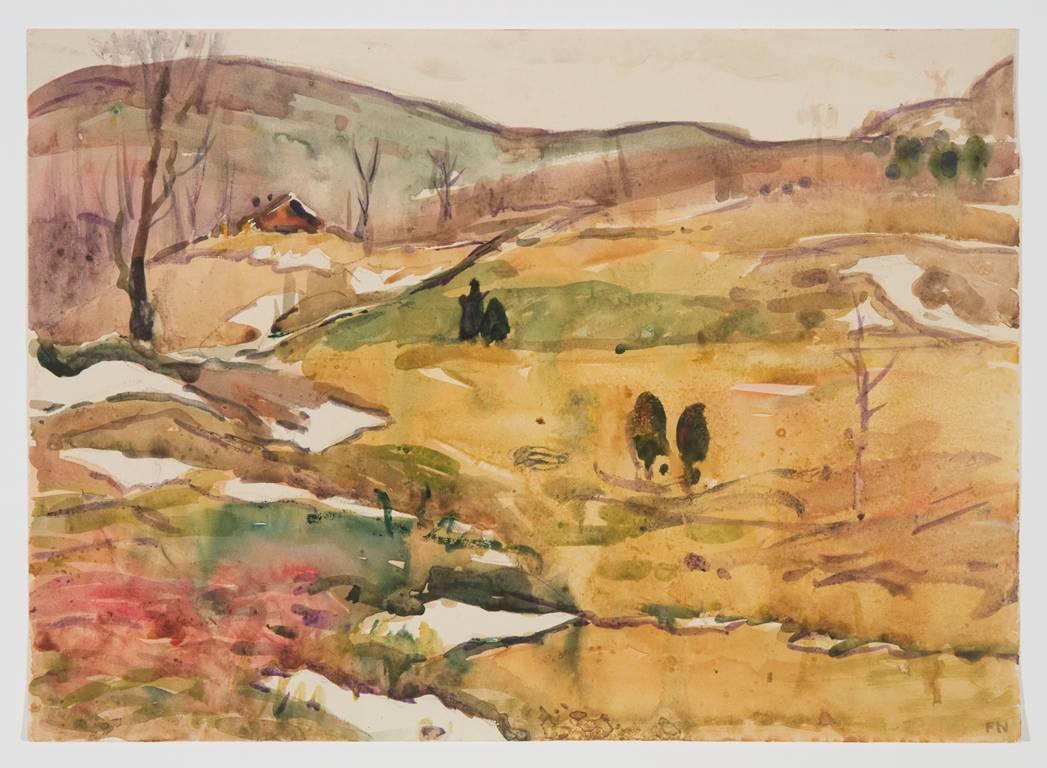
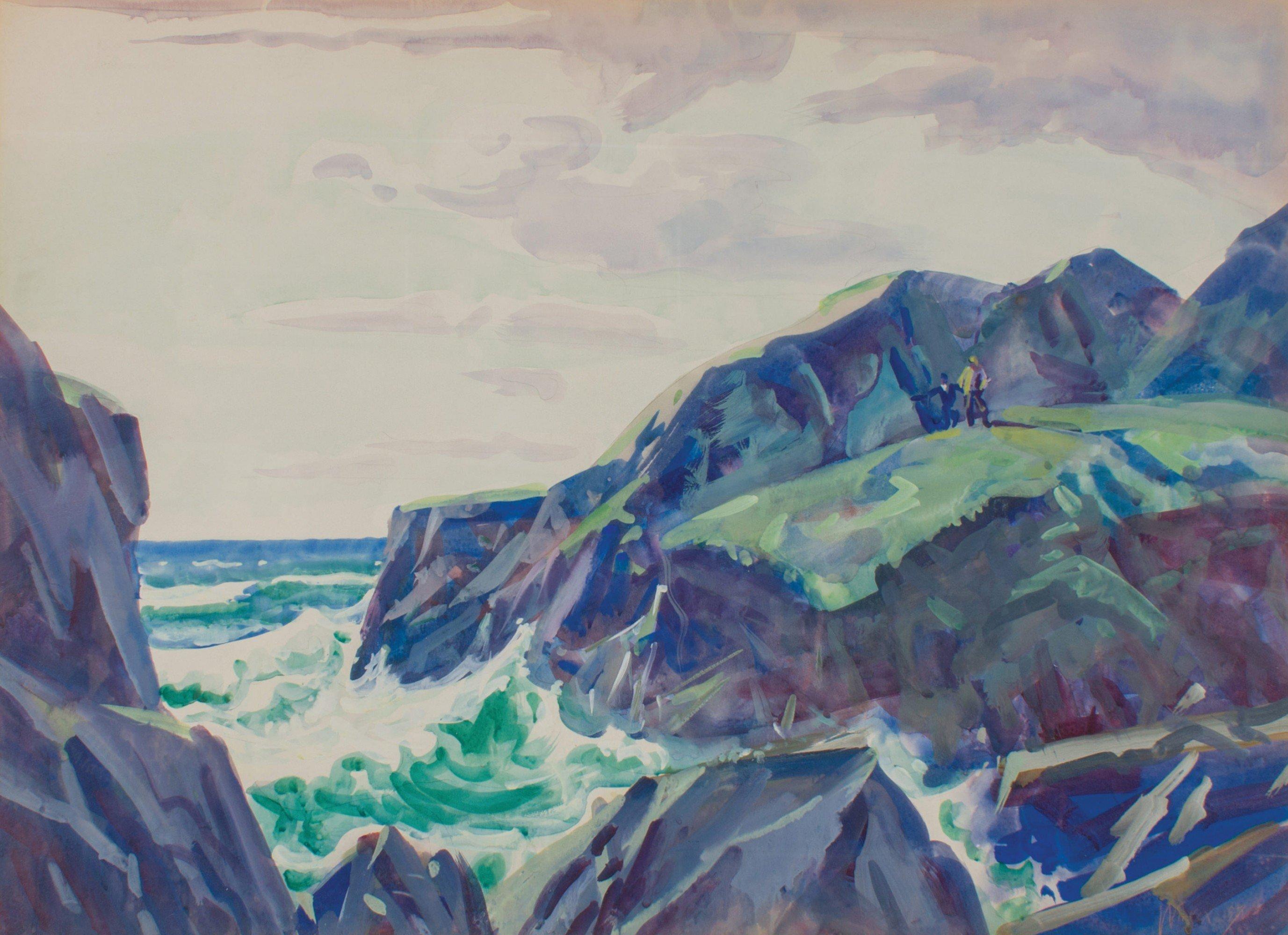
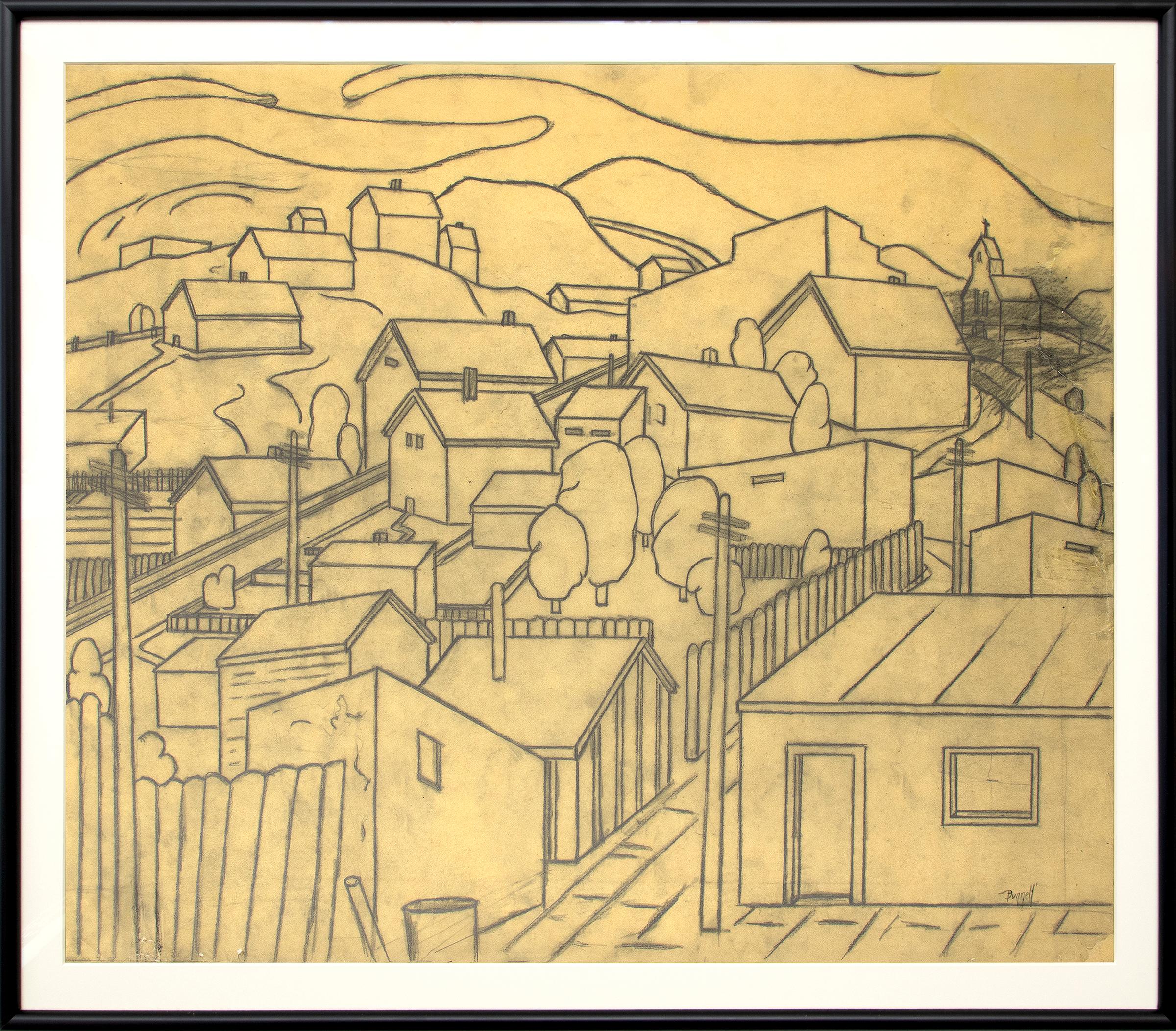
![[untitled] Street Scene with Fruit Vendor.](https://a.1stdibscdn.com/a_3312/1641486106885/sanchez_fruit_vendor_79509_master.jpg)
